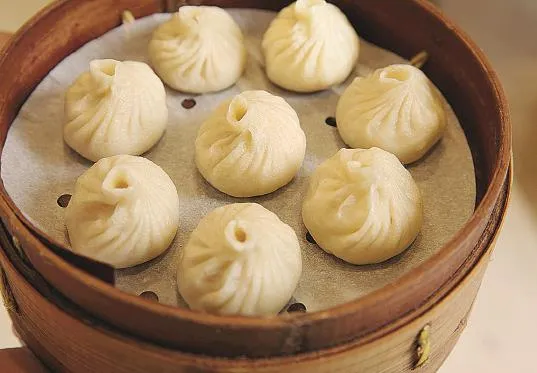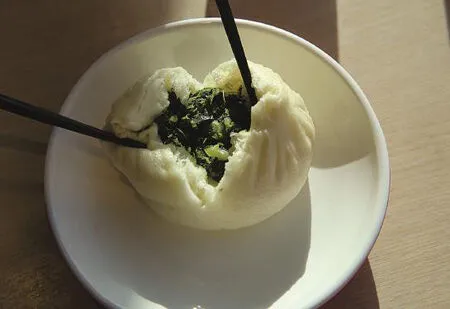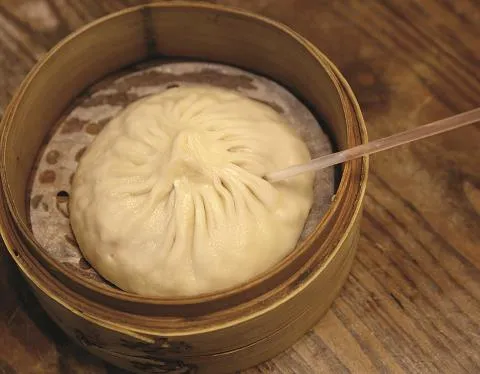Baozi: including all tastes
Baozi: including all tastes
Baozi is a type of steamed, fi lled bun or bread-like item in various Chinese cuisines. As there are many variations as to what the fi llings may be and the way it is prepared, it is typically fi lled with meat or vegetables. The name “baozi” was fi rst mentioned in the Song Dynasty, in reference to the food that the emperor awarded to his vassals in a historical book titled “Yan Yi Yi Mou Lu”, with the added explanation of it being “another name for mantou”, which is a type of cloud-like steamed bread or bun popular in Northern China. Thanks to the Grand Canal, baozi has been spread widely across China and presented in unique styles with each of them featuring their own local characteristics.
开封灌汤包子吃法讲究,轻轻提、满满移、先“开窗”(咬一小口)、一口吃、后喝汤、满嘴香。
“包”容百味
包子一词最早始于宋代都城汴梁(今开封),《燕翼诒谋录》载:“仁宗诞日,赐羣臣包子。”包子后注曰:“即馒头别名”。馒头之有馅者,北人谓之包子。早在千年前,包子已随着大运河的连通传便大江南北,又融入当地的饮食习惯,风味各有不同。
Guantangbao in Kaifeng
Kaifeng has a long history regarding its famous night market where a wide range of speciality food such as beef seasoned with soy sauce, Tangbao, fi ve-spice bread, steamed pies and dumplings are all on sale. ln the evening, Kaifeng's streets turn into restaurants while hundreds of vendors open their stands and begin selling food for people from nearby cities, as the atmosphere is both casual and very appealing. The primary night fairs in Kaifeng are near the Drum Tower, Xisi, Millennium City Park and so on.
Among all of their food specialities, Guantangbao, or the soup-fi lled bun, is a special one with a history that's thousands of years old. They are a large, soupfi lled type of steamed buns (baozi) that are famous in Chinese cuisine. All of these buns are made by wrapping a gelatinous fi lling in dough, which is then steamed in order to melt the fi lling into soup.
开封灌汤包
少有人知晓,中国流传千年的夜市发源于开封,至今开封夜市总体的数量和单体规模都堪称全国城市之最。人声鼎沸,商家和游客云集的主要夜市有鼓楼、西司、学院门、清明上河园、小宋城等。酱牛肉、灌汤包子、杏仁茶、涮牛肚、炒凉粉、黄焖鱼、五香羊蹄……整个鼓楼广场的上空充盈着各种食物的香气。当然,最具风味特色的当属“中州第一膳食”开封灌汤小笼包,至今已有近千年的历史。
开封灌汤包皮馅分明,色白筋柔,灌汤流油,鲜香有味,比普通包子略小,“提起象灯笼,放下似菊花”的优美形状令人喜爱。吃法亦是奇特讲究,轻轻提、慢慢移、先“开窗”(咬一小口)、一口吃、后喝汤、满嘴香。最具代表的要属开封“第一楼小笼灌汤包子”,据《东京梦华录》载,时名为“王楼山洞梅花包子”,号称“在京第一”。后经历代名厨师承和发展,演变为现在的“第一楼小笼灌汤包子”。
The traditional Tangbao in Kaifeng is a large bun, with its shape being similar to other baozi. Different from baozi, if you want to enjoy a Tangbao, fi rstly it should be bitten open to release the soup fi lling, which as the old saying goes, is called “opening the window”. Only after this can you eat the Tangbao, and drink the soup within.
ln the olden days, these Tangbao in Kaifeng gained fame for being “No. 1 in the world”. Now you are still able to try these old fashioned buns that inherited this famous “No.1 in the world” praise in Kaifeng.

Suzhou Xiaolongbao苏州的小笼包口味偏甜,正是这股“甜”味,方显其独特的苏州小笼味道。
Xiaolongbao in Suzhou
lt is a tradition for Suzhouers to refer to mantou as baozi. Thus, in their mouth, “small mantou” means small Baozi or Xiaolongbao.
Xiaolongbao is a type of Baozi from the Jiangnan region of China. lt is traditionally prepared in xiaolong, small bamboo steaming baskets, which gives them their name. The buns are served hot in these bamboo baskets in which they were steamed, usually on a bed of dried leaves or a paper mat. The buns are usually dipped in Zhenjiang vinegar with ginger slivers and are traditionally served with a clear soup on the side.
Xiaolongbao in Suzhou has quite a sweet taste, which makes it different from those in other places, and are traditionally fi lled with pork. One popular and common variant is pork with minced crab meat and roe. More modern innovations include other meats, seafood and vegetarian fi llings, as well as other possibilities including mashed taro.
苏州小笼包
苏州人喜欢将包子叫馒头,肉馒头、菜馒头……同时他们更喜欢将苏州小笼包叫小馒头。苏州的小笼包与别地不同,口味偏甜,但正是这股“甜”味,方显其独特的苏州小笼味道。馅料多以鲜肉、原味、蟹黄、蟹肉、虾仁等为主,一些时尚小资的小吃店则推出芋泥小笼,真心满足你的味蕾。

Yangzhou Caibao鲜美的菜包与汤包一样受扬州人的喜爱。

Yangzhou Tangbao现在的扬州人品尝扬州汤包多喜欢用吸管吸汤。
Tangbao in Yangzhou
lf you want to experience the typical Yangzhou-style way of life, you can wander in the morning to a teahouse to enjoy tangbao while drinking green tea, and then make use of the public baths in the evening. This would be a regular day for many Yangzhouers.
Tangbao from Yangzhou is often served in its own individual steaming basket since the large steamed bun contains a soup fi lling made with pork gelatin and sometimes crab roe. The soup inside is consumed through a straw, with the rest of the bun eaten afterwards. lt is often served with ginger slices and vinegar. Some foreigners even joke it's similar to “drinking hot cola packed with bread”.
扬州汤包
走在扬州大街上,总会看到“早上皮包水,晚上水包皮”几个字,讲的正是扬州人早上到茶馆里吃扬州汤包,晚上到澡堂里泡澡的生活。清早,在依着古运河或小湖畔的茶楼里,品着淡淡清香的绿茶,来一笼著名的扬州汤包,美味、悠闲、惬意自在其中。扬州汤包的最大特点就是用单只小笼或小碗分装,自成一格。最有趣的是,有别于其他汤包“轻轻提、慢慢移、先开窗、后喝汤”的品尝习惯,现在人们吃扬州汤包时多喜欢用吸管饮汤,老外更戏称这是“吸包在面皮里的热可乐”。
扬州汤包的外形和普通包子大体相仿,特点是皮薄汤浓、鲜而不腻、醇烫味美、余味悠长。在众多扬州汤包中,尤以蟹黄汤包为最,馅料多选用活湖蟹、鲜猪腿肉和散养老母鸡等上佳原料秘制。

